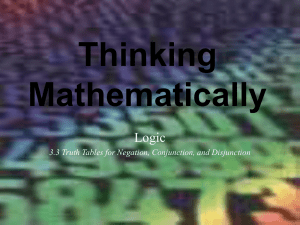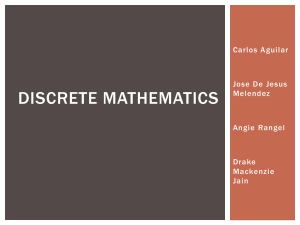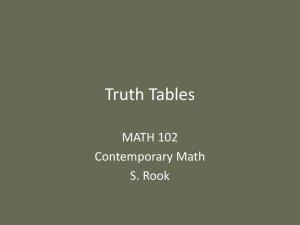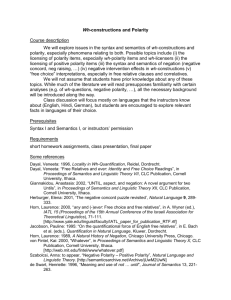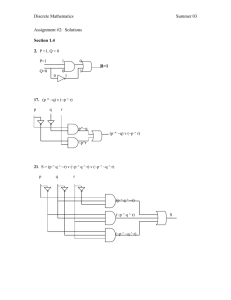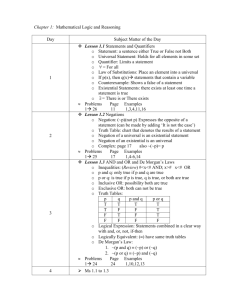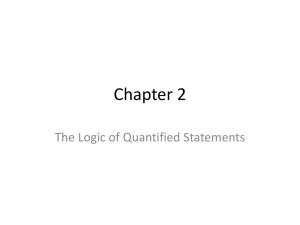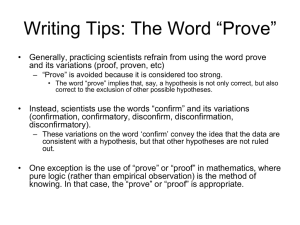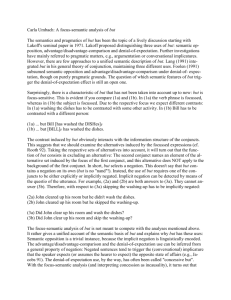Lecture 5 – March 13 Negation 1.
advertisement
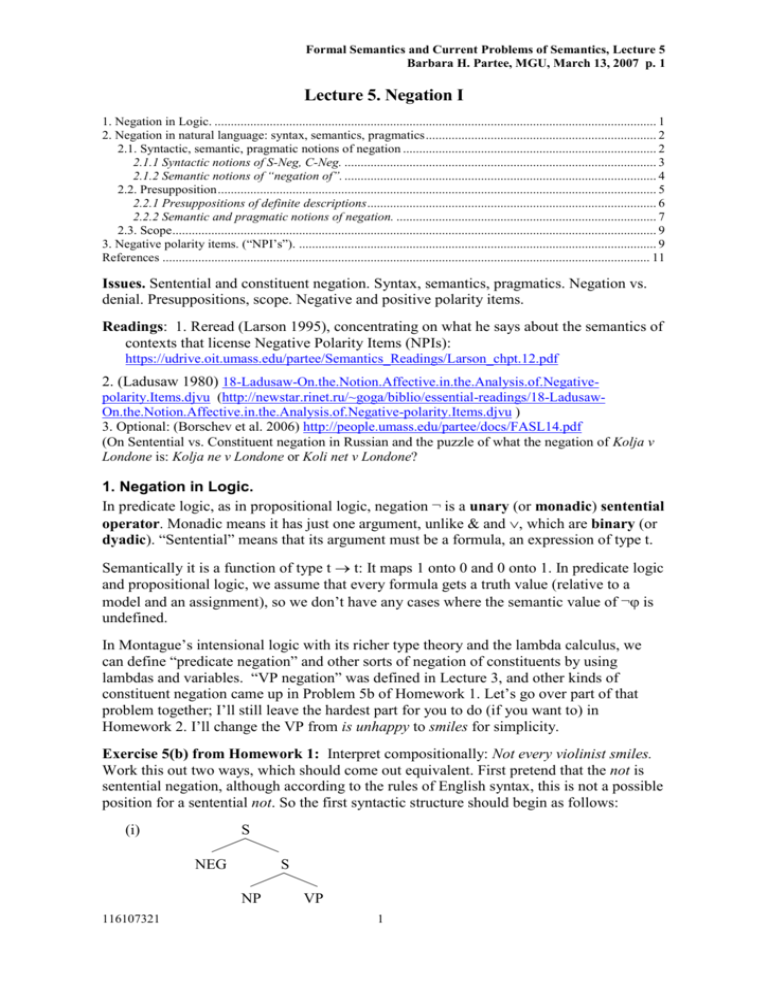
Formal Semantics and Current Problems of Semantics, Lecture 5 Barbara H. Partee, MGU, March 13, 2007 p. 1 Lecture 5. Negation I 1. Negation in Logic. ........................................................................................................................................ 1 2. Negation in natural language: syntax, semantics, pragmatics ....................................................................... 2 2.1. Syntactic, semantic, pragmatic notions of negation .............................................................................. 2 2.1.1 Syntactic notions of S-Neg, C-Neg. ................................................................................................ 3 2.1.2 Semantic notions of “negation of”. ................................................................................................ 4 2.2. Presupposition ....................................................................................................................................... 5 2.2.1 Presuppositions of definite descriptions ......................................................................................... 6 2.2.2 Semantic and pragmatic notions of negation. ................................................................................ 7 2.3. Scope ..................................................................................................................................................... 9 3. Negative polarity items. (“NPI’s”). .............................................................................................................. 9 References ...................................................................................................................................................... 11 Issues. Sentential and constituent negation. Syntax, semantics, pragmatics. Negation vs. denial. Presuppositions, scope. Negative and positive polarity items. Readings: 1. Reread (Larson 1995), concentrating on what he says about the semantics of contexts that license Negative Polarity Items (NPIs): https://udrive.oit.umass.edu/partee/Semantics_Readings/Larson_chpt.12.pdf 2. (Ladusaw 1980) 18-Ladusaw-On.the.Notion.Affective.in.the.Analysis.of.Negativepolarity.Items.djvu (http://newstar.rinet.ru/~goga/biblio/essential-readings/18-LadusawOn.the.Notion.Affective.in.the.Analysis.of.Negative-polarity.Items.djvu ) 3. Optional: (Borschev et al. 2006) http://people.umass.edu/partee/docs/FASL14.pdf (On Sentential vs. Constituent negation in Russian and the puzzle of what the negation of Kolja v Londone is: Kolja ne v Londone or Koli net v Londone? 1. Negation in Logic. In predicate logic, as in propositional logic, negation ¬ is a unary (or monadic) sentential operator. Monadic means it has just one argument, unlike & and , which are binary (or dyadic). “Sentential” means that its argument must be a formula, an expression of type t. Semantically it is a function of type t t: It maps 1 onto 0 and 0 onto 1. In predicate logic and propositional logic, we assume that every formula gets a truth value (relative to a model and an assignment), so we don’t have any cases where the semantic value of ¬ is undefined. In Montague’s intensional logic with its richer type theory and the lambda calculus, we can define “predicate negation” and other sorts of negation of constituents by using lambdas and variables. “VP negation” was defined in Lecture 3, and other kinds of constituent negation came up in Problem 5b of Homework 1. Let’s go over part of that problem together; I’ll still leave the hardest part for you to do (if you want to) in Homework 2. I’ll change the VP from is unhappy to smiles for simplicity. Exercise 5(b) from Homework 1: Interpret compositionally: Not every violinist smiles. Work this out two ways, which should come out equivalent. First pretend that the not is sentential negation, although according to the rules of English syntax, this is not a possible position for a sentential not. So the first syntactic structure should begin as follows: (i) 116107321 S 3 NEG S 3 NP VP 1 Formal Semantics and Current Problems of Semantics, Lecture 5 Barbara H. Partee, MGU, March 13, 2007 p. 2 For (i), you just work out the interpretation of Every violinist smiles compositionally, and then add sentential “not”, which is just the logical ¬, at the last step. The result will be: ¬ x(violinist (x) smile (x)). (ii) Then figure out what the type and translation should be for a not which can apply to NPs of type (e t) t, and work out the translation for the sentence under an NPnegation analysis, where the syntactic structure begins as follows: (ii) S 3 NP VP 3 NEG NP This one is more challenging. Let’s call this not NEGNP, analogous to the NEGVP in Lecture 3. The type of this negation must be (((et)t) ((et)t)), a function from NP-type to NP-type. (Note: There’s no analogous way to define constituent negation for e-type NPs. We can discuss this.) I’ll use the blackboard to show how to arrive at the answer. It will help if we go back to answer (i) and leave the NP meaning as a constituent, showing the compositional structure of the first meaning. ¬ ((Every (violinist)) (smiles)) Now let’s use T as a variable of generalized quantifier type, ((et)t), and P as a variable of property type et. And we want TR(NEGVP) to be a function such that TR(NEGVP) (TR (every violinist)) will be a function that can apply to TR(smiles) to give something equivalent to ¬ ((Every (violinist)) (smiles)) . Then what we need for TR(NEGVP) is this: λTλP[¬T(P)]. Check this out by applying it to (TR (every violinist)), then simplifying, then applying the result to TR(smiles), (iii) There is a third possibility (which may very well be the linguistically correct one), which is to apply not to every; if you have figured out how to do (i) and (ii), you should be able to figure out how to do the third. This last version is a little harder, but it’s just more lambdas. Can you think of linguistic arguments for or against this structure? I’ll leave it as one of the options for Homework 2! 2. Negation in natural language: syntax, semantics, pragmatics 2.1. Syntactic, semantic, pragmatic notions of negation In classical semiotics (Morris 1938), syntax treats properties of expressions; semantics relates expressions to their denotata; pragmatics relates expressions, their denotata, and their uses in possible contexts. Similarly we need to distinguish syntactic, semantic, and pragmatic notions relating to negation, and doing so is not always simple. The question “Is sentence S1 the negation of sentence S2?” is not a single question; it is only in the simplest cases that it may seem so. 116107321 2 Formal Semantics and Current Problems of Semantics, Lecture 5 Barbara H. Partee, MGU, March 13, 2007 p. 3 For many sentences, such as (1a), “what their negation is” is uncontroversial. (1) a. Petrov b. Petrov c. Petrov rabotaet v Akademii. ne rabotaet v Akademii. rabotaet ne v Akademii. Everyone would agree that the negation of (1a) is (1b). Sentence (1b) is an instance of syntactic sentential negation (S-Neg), and semantically it expresses the contradictory of (1a) (at least if we don’t worry about the presupposition of existence of Petrov). Constituent negation (C-Neg) gives a contrary proposition (1c). It may be used to deny (1a), but one wouldn’t call it “the negation of (1a).” We might say that the “ideal negation” of an affirmative sentence is a sentence which uses S-Neg, expresses the contradictory of , and in all other respects has the same structure as apart from the addition of negation. But not every sentence admits of an “ideal negation”, and the relation between affirmative and negative sentences can raise puzzles. One example of such a puzzle, which we will return to when we discuss the Russian Genitive of Negation and the distinction between “Locative” and “Existential” sentences in later lectures is this: what is the negation of (2)? (2) Kolja v Londone. There are two potential candidates, (2-NE) and (2-NET)1. But we will not discuss them today, except to mention the question of whether (2-NE) is S-Neg or C-Neg. (2-NE) Kolja (2-NET) Koli ne net v Londone. v Londone. 2.1.1 Syntactic notions of S-Neg, C-Neg. English: Jespersen’s Nexal/Special Neg, Klima’s S-Neg, C-Neg. As Horn (1989) observes, Jespersen’s (1924) and Klima’s (1964) criteria for S-Neg in English can conflict. Jespersen’s criterion for S-Neg (“nexal negation”) is canonical position of the negative morpheme; Klima’s is a battery of tests including tag questions, too vs. either tags, so vs. neither conjunction. Both regard John didn’t arrive, John didn’t eat anything as S-Neg; both regard They’re arguing about nothing as C-Neg. But some Jespersen C-Neg (‘special negation’) cases clearly come out as S-Neg for Klima, e.g. No one objected, John ate nothing, Not everyone agreed. Russian: Russian syntactic S-Neg, C-Neg. For Russian, Jespersen’s and Klima’s criteria converge: translations of Klima’s S-Neg sentences do almost all have pre-verbal ne. So for Russian the syntactic terms S-Neg/CNeg correspond to Russian priglagol’noe/ nepriglagol’noe otricanie ‘preverbal/ nonpreverbal negation’. (3) a. Russian Syntactic S-Neg: Ivan ne prišel. ‘Ivan didn’t come.’ Nikto ne prišel. ‘No one came.’ On ne rešil vsex zadač. ‘He didn’t solve every problem.’ Vsego ja ne ponjal. ‘I didn’t understand everything.’ b. Russian Syntactic C-Neg: Èto byl ne portret. ‘That wasn’t a portrait.’ Prišel ne Ivan. ‘Not Ivan came.’ Petja ezdit ne bystro. ‘Petja drives not quickly.’ On rešil ne vse zadači. ‘He 1 This question was first discussed by Arutjunova (1976, p.144), who observed that a yes-no locative question like Kolja v Londone? admits two alternative forms for a negative answer, (2-NE), whose form corresponds to that of the affirmative (2), and (2-NET), whose form is like that of an existential sentence. She notes that (2-NET) is more widely used, and that (2-NET) expresses general sentential negation. 116107321 3 Formal Semantics and Current Problems of Semantics, Lecture 5 Barbara H. Partee, MGU, March 13, 2007 p. 4 didn’t solve every problem.’ Ja ponjal ne vsë. ‘I didn’t understand everything.’ c. Unclear cases: Kolja ne v Londone. Kolja ne gotov. Kolja ne ženat. Kolja ne durak. ‘Kolja is not in London/ ready/ married/ a fool.’ The main unclear cases for Russian are present tense BE sentences with no overt verb like (2-NE). The question is whether such sentences have the structure in (4a) or (4b), or are ambiguous. It can be argued that they in fact have the constituent-negation structure in (4a) (Borschev et al. 2006). (4) a. Constituent-negation structure: Kolja be [ne [v Londone]] b. Sentential-negation structure: Kolja [ne [be v Londone]] Below we review two prominent syntactic properties of Russian C-Neg and S-Neg sentences, before turning in Section 2.1.2 to semantic notions; we will discuss pragmatic notions in Section 3. Properties of Syntactically S-Neg sentences in Russian. For Russian, S-Neg sentences differ in systematic ways from C-Neg sentences. We mentioned in Section 1 that S-Neg and not C-Neg licenses Gen Neg. Ni-words and niphrases are also licensed by S-Neg and not by C-Neg. We illustrate with the licensing of ni – ni coordinations. (5) a. Ni tvoja, ni moja kniga ne byla na stole. b. *Ni tvoja, ni moja kniga byla ne na stole. (no licensing by C-Neg ‘not on the table’) (6) a. Ni my, ni oni ne rešili vsex zadač. b. *Ni my, ni oni rešili ne vse zadači. (no licensing by ‘not all the problems’) (7) a. Mal’čiki ne prigotovili ni ris, b. * Ne mal’čiki prigotovili ni ris, (no licensing by ‘not the boys’) ni kartoshku. ni kartoshku. And as is well known (Peškovskij 1956, Babby 1980), syntactic S-Neg licenses Gen Neg, and C-Neg does not, even in cases where the semantics is virtually indistinguishable, as in the NEG > reading shared by (8a-b), either of which could be considered a semantic negation of (9) under one or more of the construals of that notion below. (8) a. My ne rešili vsex zadač. b. My rešili ne vse zadači / *vsex zadač. (9) My rešili vse zadači. Even the syntactic C-Neg in (10b) does not license Gen Neg, although its translation into English would come out as syntactic S-Neg on Klima’s tests. It is semantically negative on Padučeva’s (1974) definition of ‘general negation’, since it is the semantic contradictory negation of the corresponding sentence without the ne. And the VP of such a sentence is clearly a Downward-Entailing context (Ladusaw 1980) as shown in (11). (10) a. Nikto ne videl Mašu / Maši. b. Ne vse mal’čiki videli Mašu / *Maši. (11) Ne vse mal’čiki priexali do 3-x Ne vse mal’čiki priexali do 2-x. 2.1.2 Semantic notions of “negation of”. It is principally in semantics that we find (various) definitions of what it is for one sentence to be the negation of another, or more strictly, for one proposition to be the 116107321 4 Formal Semantics and Current Problems of Semantics, Lecture 5 Barbara H. Partee, MGU, March 13, 2007 p. 5 negation of another.2 The familiar truth-tables of logic present the simplest case, an idealization: assume that all propositions are true or false (i.e., ignore presuppositions), and define negation truth-functionally: p is T(rue) if and only if p is F(alse). When applied to natural language phenomena, this notion is referred to as propositional (contradictory) negation. Contrary negation is a weaker notion: q is a contrary negation of p iff p and q cannot both be true but can both be false. (X) a. p2 is a contradictory negation of p1: p2 is true iff p1 is false. b. p2 is a contrary negation of p1: p2 and p1 cannot both be true but can both be false. Sentence (1b) expresses the contradictory of (1a); (1c) expresses a contrary of (1a). The status and treatment of presuppositions, and of linguistically encoded “pragmatic” factors such as Topic-Focus structure and point of view, complicate the picture. In current dynamic theories, the line between semantics and pragmatics is not sharp or stable. But whatever the labels, it is important to take presuppositions and context into account, since these crucially affect the background universe U of relevant possibilities. So let’s consider presuppositions and then return to semantic vs. pragmatic notions of negation. 2.2. Presupposition (Levinson 1983, Chs. 3,4, Chierchia and McConnell-Ginet 1999, Ch. 6, Kadmon 2001) A presupposition is (a) backgrounded and (b) taken for granted, i.e. assumed by the speaker to be already assumed by the hearer to be true. A classic definition of semantic presupposition: A sentence S presupposes a proposition p if p must be true in order for S to have a truth-value (to be true or false). *Note that this requires that we allow some sentences to lack a truth-value; this definition does not make sense if we work with a strictly bivalent logic, in which each sentence must be either true or false. An approximate definition of pragmatic presupposition: A use of a sentence S in a context C pragmatically presupposes a proposition p if p is backgrounded and taken for granted by the speaker in C. Padučeva (1985, p. 58), who distinguishes presuppositions of sentences from presuppositions of speakers, makes a useful and slightly different distinction between semantic and pragmatic presuppositions of sentences: A semantic presupposition of a sentence S is a proposition which the hearer must consider true in order for the sentence S to make sense; A pragmatic presupposition of S is a proposition which should be already known to the hearer in order for the assertion of S to be appropriate in the context. In both versions, a semantic presupposition of a sentence S is one that is needed in order for the sentence to get a proper semantic interpretation, whereas a pragmatic presupposition is a condition on the contexts in which the sentence can be used felicitously. What we are interested in is a “correspondence” notion of “negation of”, in which we consider pairs of affirmative and negative sentences which would be well-formed in the same contexts, e.g. with respect to an implicit background YesNo question. This is not the same as the notion of “denial of”, a discourse relation of an utterance to a preceding (or implicit) assertion. 2 116107321 5 Formal Semantics and Current Problems of Semantics, Lecture 5 Barbara H. Partee, MGU, March 13, 2007 p. 6 The terms felicitous, infelicitous are standardly used for pragmatic (in)appropriateness in a given context. We can contrast the following ways a sentence can be “bad”: Sentence S is syntactically ill-formed. Sentence S is semantically anomalous, or has no truth-value (in any context). Sentence S cannot be felicitously used in context C. The mark “*” is used for syntactic ill-formedness. The mark “#” is often used for both semantic and pragmatic anomaly, not always sharply distinguished. Test for backgrounding: p is in the background of S if p is implied by all of the sentences in the “S family”: (12) a. S b. It is not the case that S. c. Is it the case that S? d. If S, then S’. Example: (13) “Joan has stopped drinking wine for breakfast.” Presupposition: Joan used to drink wine for breakfast. Similar Russian examples in Padučeva (1985), p. 61-62: (14) V dva časa Džon načal rabotat’. ‘At 2 o’clock John started to work.’ Presupposition: At some time before 2 o’clock, John wasn’t working. Assertion: At some time after 2 o’clock, John was working. Backgrounded but not presupposed: non-restrictive relative clauses. (15) Jill, who lost something on the flight from Ithaca to NYC, likes to travel by train. A number of authors have considered the embedded proposition, that Jill lost something on the flight from Ithaca to New York, to be a presupposition (Keenan 1971, Levinson 1983), but arguments against considering it a presupposition can be found in Padučeva (1985, p.65) and later in (Chierchia and McConnell-Ginet 1999, Kadmon 2001, Potts 2005). Contrasting sentence with a real presupposition: Pseudo-cleft construction. (16) What Jill lost on the flight from Ithaca to New York was her new flute. 2.2.1 Presuppositions of definite descriptions (17) “After the separation of Schleswig-Holstein from Denmark, Prussia and Austria quarrelled.” : Example from Frege (1892). Frege states that the thought that Schleswig-Holstein was once separated from Denmark “is the necessary presupposition in order for the expression “After the separation of Schleswig-Holstein from Denmark” to have any reference at all. (18) a. b. The present king of France is bald. The present king of France is not bald. This is a classic example discussed by Russell and by Strawson. Russell analyzed (18b) as ambiguous, treating the conditions of existence and uniqueness as part of the truth-conditions of the sentence. If there is no king of France, (18b) would come out true on Russell’s analysis if negation has wide scope, false if the definite description has wide scope. 116107321 6 Formal Semantics and Current Problems of Semantics, Lecture 5 Barbara H. Partee, MGU, March 13, 2007 p. 7 (Optional exercise: You could work out a Russellian analysis of this kind explicitly by using our fragment, with Montague’s <<e,t>,t> type analysis of “the king”. ) Strawson argued that it is more normal to consider (18b) neither true nor false if there is no king of France. Strawson’s analysis corresponds to our e-type treatment of definite descriptions. If you try to evaluate (18b) using a Strawsonian analysis, assuming there is no king of France, then the subject NP will get no semantic value. And we assume that if one of the parts has no semantic value, then the whole sentence has no semantic value. (19) Chirac is not the king of France. As Strawson noted, a sentence like this does not lack a truth value: it seems to be definitely true. For this example (but not for all), we can capture the absence of presupposition by using the predicative <e,t> meaning of the definite description proposed in (Partee 1986) (see Lecture 6). In other examples, as argued by Hajičová (1984), ThemeRheme structure may be crucial: a definite description that is part of the Theme (Topic) carries a presupposition of existence and uniqueness; but a definite description that constitutes all or part of the Rheme (Focus) seems to carry only an “allegation”, or cancellable implicature, of existence and uniqueness. (20) a. Our defeat was not caused by Bill’s cousin. b. Bill’s cousin did not cause our defeat. Potential presuppositions: (i) we were defeated. (“our defeat” has a reference.) (ii) Bill has a cousin. Test for cancellability: (21) a. “ ... , in fact Bill does not have a cousin.” (ok after 20a, not after 20b) b. “ ..., in fact this time we achieved a great victory.” (ok after 20b, not after 20a) A good discussion of referential status of a variety of kinds of noun phrases, and their associated presuppositions, can be found in Chapter 4 of (Padučeva 1985). 2.2.2 Semantic and pragmatic notions of negation. Since pragmatics concerns relations among expressions, their denotata, and contexts of use, it is natural that pragmatic negation should be a three place relation: Pragmatic negation: Given contextual assumptions3 , a speaker may use sentence S’ with semantic interpretation q as the pragmatic negation of sentence S with interpretation p if relative to all situations which satisfy , q is the contradictory (i.e. complement) of p. Negation vs. denial: The notion of pragmatic negation defined above is not the same as denial, which is a particular kind of speech act, one that presupposes that the proposition being denied is already in some sense “present” in the context. A sentence S’ which may be a pragmatic negation of sentence S in context C may be used as an independent assertion, or it may be used to deny S, depending on the speaker’s intentions and other facts about the context. We can illustrate the notion of pragmatic negation clearly with our Petrov example (1a-c). Imagine a universe U partitioned into 4 types of situations: W1, worlds in which Petrov does not exist; W2, in which Petrov exists but doesn’t work; W3, in which Petrov works but not at the Academy; and W4, in which Petrov works at the Academy. 3 Contextual assumptions may include pragmatic presuppositions plus further assumptions about the conversational background and context of utterance. 116107321 7 Formal Semantics and Current Problems of Semantics, Lecture 5 Barbara H. Partee, MGU, March 13, 2007 p. 8 Table 2 Propositions -------------------Classes of situations4 W1: There’s no (1ai) Petrov]TOPIC rabotaet v Akademii (1aii) [Petrov rabotaet]TOPIC v Akademii (1b) [Petrov]TOP ne rabotaet v Akademii (propositional neg) (1c) [Petrov rabotaet]TOPIC ne v Akademii (local neg) # (False) # (False) # (True) # (False) False # (False) True # (False) False False True True True True False False Petrov W2: Petrov doesn’t work anywhere W3: Petrov works, but not at the Academy W4: Petrov works at the Academy KEY: # = violation of a pragmatic presupposition: infelicitous in such contexts (Here we are following Horn’s analysis, treating presuppositions as pragmatic.) The affirmative (1a) is true in W4. It is felicitous but false in W2 and W3. What is its contradictory negation? Relative to U, ignoring all presuppositions, even the existence of Petrov, the answer is W1 W2 W3, -- but that’s not a realistic interpretation of (1b). For a more realistic interpretation of (1b), we consider only contexts (situations) in which Petrov exists5, shrinking U to W2 W3 W4. (Cutting off the top row of the chart.) The affirmative (1a) with Petrov as Topic is true in W4.and false in W2 and W3; and (1b) is its contradictory, while (1c) is only a contrary. Now suppose we take Petrov works to be Topic in (1c) and in (1a) on one reading; that will carry the pragmatic presupposition that Petrov works, shrinking the relevant universe U to just W3 W4, the bottom 2 rows. There the contradictory of (1a) is equally expressed by (1b) and (1c). Then it’s natural for the speaker to use the more informative (1c) to negate (1a). So (1c) is a good “pragmatic negation” of (1a) in such a context: it is more informative than (1b), and its user conveys presuppositions she presumes are shared. If we treat most presuppositions as pragmatic, then Padučeva’s (1974) general negation may be viewed as pragmatic negation: it amounts to contradictory negation in a universe U that has been restricted to include only possible worlds in which all presuppositions are satisfied, but as contrary negation in an unrestricted, maximal universe. There seem to be differences between Russian and English in the choice of S-Neg vs. C-Neg to express general negation (cf. Padučeva 1974, p. 152) in contexts where they are pragmatically equivalent. But a full discussion would have to go further into presuppositions and topic-focus articulation (Padučeva 1985, Rooth 1992, Hajičová et al. 1998) than we can do here. 4 For graphic simplicity, we are oversimplifying, and not distinguishing in the left-hand column the roles of situations as contexts of utterance and as ‘partial possible worlds’, points of evaluation for truth and falsity. Distinguishing these roles would require a 3-dimensional chart. Not distinguishing may be confusing, though. These topics could fill a whole course! 5 This may be considered a semantic presupposition of the proper name. 116107321 8 Formal Semantics and Current Problems of Semantics, Lecture 5 Barbara H. Partee, MGU, March 13, 2007 p. 9 2.3. Scope We will not have time today for a full discussion of scope. Let me just mention a few points that are especially important with respect to the topic of Genitive of Negation in Russian, which we will start discussing in Lecture 7. Ambiguity involving negation and NPs can be handled formally by the same mechanisms of “Quantifying In” that we discussed in connection with quantifier scope. (22) John didn’t solve 10 problems. (i) ¬ > 10 (“Neg has wider scope than 10”): there aren’t 10 that he solved; he solved fewer than 10. (In Russian I believe this reading requires i or ni before “10”.) (ii) 10 > ¬ : There are 10 problems that he didn’t solve. We would derive reading (ii) by “quantifying in” the NP “10 problems”. It is often difficult to distinguish “scope” from “pseudo-scope” (Kratzer 1998). The debate between Russell and Strawson about The present king of France is not bald is in part a debate about whether to treat the present king of France as a quantifier with two different possible scopes, or to treat it (at least on one reading) as a referential expression for which scope is just as irrelevant as for John is not bald. Western Slavists mostly believe that Gen Neg in Russian marks a scope distinction. (23) a. Ivan ne našel ošibki. Narrow scope NP, relative to negation. Negation “licenses” Genitive of Negation, and the NP is normally interpreted as under its scope. b. a. Ivan ne našel ošibku. : Wide scope NP, or “referential” NP? But whether this is generally correct, or whether the issue may rather be one of the “referential status” of genitive-marked NPs, see (Partee and Borschev 2002), available here: http://people.umass.edu/partee/docs/ParteeBorschevFASL10.pdf. We will return to this question in later lectures, since we are currently working on the hypothesis that Genitive-marked NPs in Russian are (always? or only sometimes?) NPs that have been shifted to property-type readings (Partee and Borschev 2004, Kagan 2005). 3. Negative polarity items. (“NPI’s”). This is a very important topic, but we probably won’t manage to cover it today. I will include it in the handout, and talk about it next time. In English there are negative polarity items (NPI’s) which are restricted to occurring in certain contexts, of which “negative contexts” are typical “licensing” contexts, but not the only contexts. The linguistic problem is to characterize the nature of the contexts in which NPI’s can and cannot occur (and to characterize the NPI’s themselves, but we will not try to do that here.) Examples: any, anyone, anything, anywhere, ever, at all; give a damn, lift a finger, move a muscle, pay the slightest attention. (Question: what are some Russian NPI’s? There are references and discussion of NPI’s in Slavic languages in the handout of my Lecture 8 at MGU in 2005: http://people.umass.edu/partee/MGU_2005/MGU058.pdf .) Examples: (1) I did not see any lions. (2) *I saw any lions. (3) If you have any questions, you can call me. (4) Noone has ever found a unicorn. 116107321 9 Formal Semantics and Current Problems of Semantics, Lecture 5 Barbara H. Partee, MGU, March 13, 2007 p. 10 (5) *Someone has ever found a unicorn. (6) No student who knows anything about phonology would ever say that. (7) *Some student who knows anything about phonology would ever say that. (8) Every student who knows anything about phonology will know the answer. (9) *Every student who knows phonology would ever say that. The semantic generalization discovered by (Ladusaw 1979) is that NPI’s occur inside the argument of “monotone decreasing functions”. This notion is much more general than the notion of negation, and covers all of the above examples and many others; and it is an intrinsically model-theoretic concept — a real semantic property of the interpretation of the expressions, not a “formal” property of “representations” in some sort of “logical form”. Definition (general): A function f is monotone increasing if whenever a b, f(a) f(b). A function f is monotone decreasing if whenever a b, f(b) f(a). Application to determiner meanings: (Note: on the domains in our model, the basic ordering relation begins from the ordering on type t: 0 < 1; and for all types whose interpretations are sets, the corresponding notion of “less than” then becomes “subset of”. See Appendix 1 below for more details.) Definitions: A determiner D is right monotone increasing (sometimes called right upward entailing or monotone) iff whenever B C, D(A)(B) entails D(A)(C). A determiner D is right monotone decreasing (right downward entailing or monotone ) iff whenever B C, D(A)(C) entails D(A)(B). A determiner D is left monotone increasing (left upward entailing or monotone) iff whenever A C, D(A)(B) entails D(C)(B). A determiner D is left monotone decreasing (left downward entailing or monotone) iff whenever A C, D(C)(B) entails D(A)(B). Illustrations: In a structure “Det CNP VP”, the left position is the CNP argument, and the right position is the VP argument. 1. To show, for instance, that no is right monotone decreasing, we use a test like the following: (i) B C: ║knows Turkish and Chinese║║knows Turkish║ (ii) test entailment: No student knows Turkish no student knows Turkish and Chinese. Valid. So no is right monotone decreasing. 2. To show that no is left monotone decreasing, we use a test like the following: (i) ║Italian student║║student║ (ii) No student knows Urdu no Italian student knows Urdu. Valid. 3. Similarly we can show that some is right monotone increasing. (i) ║knows Turkish and Chinese║║knows Turkish║ (ii) Some student knows Turkish and Chinese some student knows Turkish. 4. Some is also left monotone increasing. (i) ║Italian student║║student║ (ii) Some Italian student knows Urdu some student knows Urdu. Valid. 116107321 10 Formal Semantics and Current Problems of Semantics, Lecture 5 Barbara H. Partee, MGU, March 13, 2007 p. 11 5. Interesting fact about every. While most determiners are like some and no in being either left and right increasing or left and right decreasing (so that it makes sense to call some “positive” and no “negative”), there are some determiners, of which the universal quantifier every is the most basic example, which have different properties for their left and right arguments. 5a. Every is left monotone decreasing: (i) ║Italian student║║student║ (ii) Every student knows Urdu Every Italian student knows Urdu. Valid. 5b: Every is right monotone increasing: (i) ║knows Turkish and Chinese║║knows Turkish║ (ii) Every student knows Turkish and Chinese Every student knows Turkish. The distribution of polarity items in the CNP part and the VP part of the sentences (4-9) above, and others like them, is accounted for by the monotonicity properties of the determiners in them. This account reinforces the analysis of determiners as functions which take a CNP as first argument, and the resulting NP interpretation (a generalized quantifier) as a function which takes the VP as its argument. Further references: see http://people.umass.edu/partee/MGU_2005/MGU058.pdf . References Arutjunova, Nina D. 1976. Predloženie i ego smysl [The Sentence and its Meaning]. Moscow: Nauka. Babby, Leonard H. 1980. Existential Sentences and Negation in Russian. Ann Arbor, Michigan: Karoma Publishers. Borschev, Vladimir et al. 2006. Sentential and constituent negation in Russian BEsentences revisited. In Formal Approaches to Slavic Linguistics: The Princeton Meeting 2005 (FASL 14), eds. James Lavine et al., 50-65. Ann Arbor: Michigan Slavic Publications. Chierchia, Gennaro, and Sally McConnell-Ginet. 1999. Meaning and Grammar. An Introduction to Semantics. Cambridge: MIT Press. Hajičová, Eva. 1984. Presupposition and Allegation Revisited. Journal of Pragmatics 8:155-167. Hajičová, Eva, Barbara Partee, and Petr Sgall. 1998. Topic-Focus Articulation, Tripartite Structures, and Semantic Content. Dordrecht: Kluwer. Horn, Laurence R. 1989. A Natural History of Negation. Chicago: University of Chicago Press. Jespersen, Otto. 1924. The Philosophy of Grammar. London: Allen and Unwin. Kadmon, Nirit. 2001. Formal Pragmatics: Semantics, Pragmatics, Presupposition, and Focus. Oxford: Blackwell Publishers. Kagan, Olga. 2005. Genitive case: A modal account. Ms. Jerusalem. Paper presented at IATL Conference, Haifa, June 22-23 2005. PDF: http://atar.mscc.huji.ac.il/~english/IATL/21/Kagan.pdf. [Reprint Edition]. Keenan, Edward. 1971. Two kinds of presupposition in natural language. In Studies in linguistic semantics, eds. C. Fillmore and T. Langendoen, 45-54. New York: Holt, Rinehart & Winston. Klima, E. 1964. Negation in English. In The Structure of Language, ed. J.; Katz Fodor, J., 246-323. Englewood Cliffs: Prentice-Hall. 116107321 11 Formal Semantics and Current Problems of Semantics, Lecture 5 Barbara H. Partee, MGU, March 13, 2007 p. 12 Kratzer, Angelika. 1998. Scope or pseudo-scope? Are there wide-scope indefinites? In Events in Grammar, ed. S. Rothstein, 163-196. Dordrecht: Kluwer. Ladusaw, William. 1979. Polarity Sensitivity as Inherent Scope Relations, University of Texas at Austin: Ph.D. dissertation. Ladusaw, William. 1980. On the notion "affective" in the analysis of negative polarity items. Journal of Linguistic Research 1:1-16. [Reprinted in Portner and Partee (2002), pp. 457-470]. Larson, Richard. 1995. Semantics. In An Invitation to Cognitive Science. Vol 1: Language, eds. Lila Gleitman and Mark Liberman, 361-380. Cambridge, MA: The MIT Press. Levinson, Stephen C. 1983. Pragmatics. Cambridge: Cambridge University Press. Morris, Charles. 1938. Foundations of the Theory of Signs. In International Encyclopedia of Unified Science, eds. Otto Neurath et al., 77-138. Chicago: University of Chicago Press. Padučeva, E.V. 1974. O semantike sintaksisa: materialy k transformacionnoj grammatike russkogo jazyka [On the Semantics of Syntax: Materials toward the Transformational Grammar of Russian]. Moscow: Nauka. Padučeva, E.V. 1985. Vyskazyvanie i ego sootnesennost' s dejstvitel'nost'ju (The Utterance and its Correspondence with Reality). Moscow: Nauka. Partee, Barbara H. 1986. Noun phrase interpretation and type-shifting principles. In Studies in Discourse Representation Theory and the Theory of Generalized Quantifiers, eds. J. Groenendijk et al., 115-143. Dordrecht: Foris. [Reprinted in Portner and Partee, eds., 2002, 357-381. Reprinted in Partee, Barbara H. 2004. Compositionality in Formal Semantics: Selected Papers by Barbara H. Partee. Oxford: Blackwell Publishing, 203-230]. Partee, Barbara H., and Vladimir Borschev. 2002. Genitive of negation and scope of negation in Russian existential sentences. In Annual Workshop on Formal Approaches to Slavic Linguistics: the Second Ann Arbor Meeting 2001 (FASL 10), ed. Jindrich Toman, 181-200. Ann Arbor: Michigan Slavic Publications. Partee, Barbara H., and Vladimir Borschev. 2004. The semantics of Russian Genitive of Negation: The nature and role of Perspectival Structure. In Proceedings of Semantics and Linguistic Theory (SALT) 14, eds. Kazuha Watanabe and Robert B. Young, 212-234. Ithaca, NY: CLC Publications. Peškovskij, Aleksandr M. 1956. Russkij sintaksis v naučnom osvešcenii [Russian syntax in a scientific light], 7th edition. Moscow: Gosučpedgiz (3rd edition 1928). Potts, Christopher. 2005. The Logic of Conventional Implicatures: Oxford Studies in Theoretical Linguistics. Oxford: Oxford University Press. Rooth, Mats. 1992. A theory of focus interpretation. Natural Language Semantics 1:75116. 116107321 12

